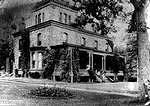Ghost Roads: The Second in an Occasional Series on the Lost Lanes and Byways of Palisades
If you have read the books of Alice Munro Haagenson and her daughter Alice Gerard, you will know that at one time there was a mansion called Glen Forest on the cliff overlooking the Hudson in what is now Tallman State Park. Glen Forest was pulled down in 1932, but early maps of our hamlet show a long lane leading from Rockland Road to the mansion, with stone bridges crossing streams, and ending with a large sweeping circle at the cliff’s edge. They also show a croquet lawn on one side of the lane and gardens on the other. All that remains of the house is an overgrown hollow and a small flight of stones once forming a cellar.
But there are other traces of Glen Forest to be found in the woods—and not just the product of my excited imagination in this month of bewitchment—traces of what must have been an impressive driveway and the gateposts guarding its entrance. The house was destroyed, but the lane still rises through the woods like mist after a rain and the gateposts remain standing, ignored, in mute testimony to their vanished past.
You’ve passed them a hundred times, a thousand, and probably have not noticed them. Today, when I went out to look at them, I couldn’t find them, either. Worried that they were finally gone, I drove back and forth on the shoulder of 9W endangering my life and that of others as I peered futilely into the brush. Eventually I parked the car and got out. On foot, just before the USE LOW GEAR sign, I saw a thick cable draped through vines and brambles and on pulling away the obscuring vegetation, found the posts, solid and true, still guarding what appeared to be an entrance into the park.
Glen Forest was built in 1867 by Peter V. King, one in the advancing tide of tycoons who traveled up the Hudson to Palisades, looking to escape the noise and filth and summer heat of New York City. It was later sold to Austin Abbott, a lawyer. The stone house, reportedly lined with cork, was called a castle by Mildred Post Rippey because of its magnificent cupola and because it stood with such imposing authority on the cliff. From its front porch, she had watched replicas of the Half Moon and the Clermont sail up the river in celebration of the Hudson-Fulton Celebration of 1909.
During the Great War, Mrs. Austin Abbott, who continued to live in the mansion after the death of her husband in 1896, came under local suspicion of selling her property to a secret organization, most likely the Germans. Actually, the buyer was Standard Oil, which planned to store oil in retaining tanks along the palisades and ship the oil from docks below the cliff. However, getting the oil down the cliff posed engineering challenges the company decided were too unwieldy to solve, and ultimately, it abandoned the project in favor of an easier location on Staten Island. The tanks were removed, and Henry Kennell, a Palisadian, was hired to blow up the remaining buildings, including, alas, the Abbott mansion itself.
I pushed through the brambles and followed the lane as far as it would take me, swamp and drowned trees on either side. The lane disappeared where the ground began to rise so I came around from the other end, the Long Path in Tallman Park, and broke out for Trail #1 which leads more or less from the ruined cellar toward 9W. Not very far in, the path diverges in two directions: the beaten path and the lane. The lane is still marked by low stone walls, paving stones, and a ruined bridge. The croquet lawn and gardens have long since gone to forest but if you are very, very quiet, the murmuring of young ladies in white summer dresses still can be heard floating in the tree tops.


